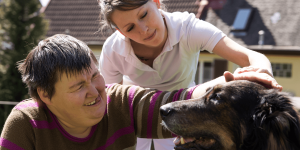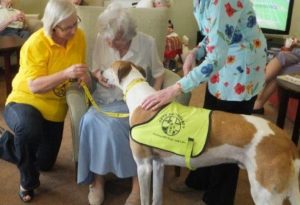Animal Assisted Interventions – Therapy Dogs.
Every loving dog owner will know that pet dogs can offer us such wonderful companionship, happiness and comfort. Animal assisted therapy can help the emotional well being of people in different settings. Nursing homes, schools, hospitals and prison establishments have all had great success employing therapy dogs.
This Holidays 4 Dogs article will consider the therapeutic value of dogs; specifically, groups and individuals with emotional needs. We also provide information on how you, and your dog, can get involved with animal assisted therapy.
A therapy dog, unlike an assistance dog, is not usually trained to perform specific tasks. However, many therapy dogs know basic tricks which delight the people they visit. Dogs are owned by volunteers who visit people in group settings, such as hospitals and hospices.
In other countries, psychiatric service dogs are trained to work with people with mental health conditions. In the UK psychiatric assistance dogs are trained to work with an individual handler.
Dogs for Good, previously known as Dogs for the Disabled, provide dogs for autistic children in the UK. They also run a PAWS project. The PAWS scheme aims to provide support to families to achieve the best relationship between the family dog and the child.
History of Therapy Dogs.
Being social creatures, dogs seem to respond to the emotions of people – often from those most vulnerable, or distressed. A dog has an uncomplicated approach to showing affection. People who are lonely, troubled, or anxious, can really benefit from interaction with a dog.
A little Yorkshire terrier called Smoky was the very first recorded therapy dog. She began her work in 1944 with the nurses at the Army and Navy and Marine hospitals in Australia. Smoky regularly accompanied Dr. Charles W. Mayo, of the famous Mayo Clinic, on hospital rounds.
During the early 1960’s, psychologist Boris Levinson was working in New York with a child who was un-communicative. After leaving the child alone for a short while with his pet dog, he returned to find the child talking to the dog. These initial observations were pivotal in the development of canine therapy.
Benefits of Therapy Dogs.
In nursing home establishments, visits from dogs (and other pets) has shown to increase socialisation between clients. Additionally, the presence of a dog increases  reactions, and positive responses to the environment – for example, with people suffering from dementia.
reactions, and positive responses to the environment – for example, with people suffering from dementia.
People with mental health issues experience decreased anxiety levels when they interact with a dog. Likewise, children with behaviour, or learning difficulties, have shown a decrease in unacceptable behaviour and agitation with animal assisted therapy.
The presence of dogs also assists the relationship between the client and therapist, or support worker, which helps to build that all important rapport. The resulting bond can make a client feel safer, and more communicative, during a therapy session.
Researchers have discovered there are also physical reasons why interaction with a dog is so beneficial to the well being of humans.
The Mayo Clinic, associated with the first ever assistance dog Smokey, now have therapy dogs that regularly visit trauma, dialysis and other units at the hospital. They firmly believe that the benefits of having the dogs visit patients, far outweigh any other potential health risks. There are many more establishments across the UK that following this view and taking a proactive interest in therapy dogs.
Can my Dog become a Therapy Dog?
Any friendly, well-mannered dog can become a therapy dog, but they must have up-to-date vaccinations. Dogs must also be registered with an organization such as Pets as Therapy (PAT), UK. Founded in 1983 PAT Dogs UK has four and half thousand dogs on its books. Volunteers and their dogs visit over 130,000 people each week!
To become a PAT dog handler volunteer you will first need to fill out an application form. You will need to include two referees and a copy of your dog’s vaccination card.
There is an annual subscription fee which goes towards the £75 yearly cost to the charity, for each volunteer. This fee covers costs such as, assessments, training courses, legal expenses, insurance etc.
Your dog will need to be a minimum of nine months old and you must have owned him for at least six months before you begin your application.
Once the initial application has been submitted, volunteers are contacted to have their dog temperament tested by an accredited PAT dog assessor. You can read more about volunteering for therapy dogs here.
Therapy dog assessment.
Your dog will undergo a temperament test to assess his suitability to become a therapy dog . Your dog must be calm and well mannered and also, should not jump-up, paw, or lick.
This is due to health issues and because sometimes, these behaviours can be a sign of stress. Barking, growling, or shying away from unexpected noises, would also mean a failed assessment. (It is fine if the dog backs away; as long as he, or she, recovers and returns to investigate without showing signs of fear).
All visitors and their dogs operate in an unpaid, voluntary capacity and provide their time freely to the charity. Volunteers can offer as many, or as few, hours as they want.
Conclusion.
There are now other non-medical settings such as conventional schools and colleges who are investing in animal assisted therapy to reduce stress and anxiety. There are even schemes that help children to improve their reading skills by reading to dogs.
settings such as conventional schools and colleges who are investing in animal assisted therapy to reduce stress and anxiety. There are even schemes that help children to improve their reading skills by reading to dogs.
Focused animal assisted therapy is capable of benefiting a range of people in different settings and who may be facing difficult challenges in their lives.
As the discipline gathers pace, a greater number of individuals and groups can benefit from the assistance of animal based interventions.
For information on the importance of pets to people with disabilities, please read our other Holidays4Dogs article here.


